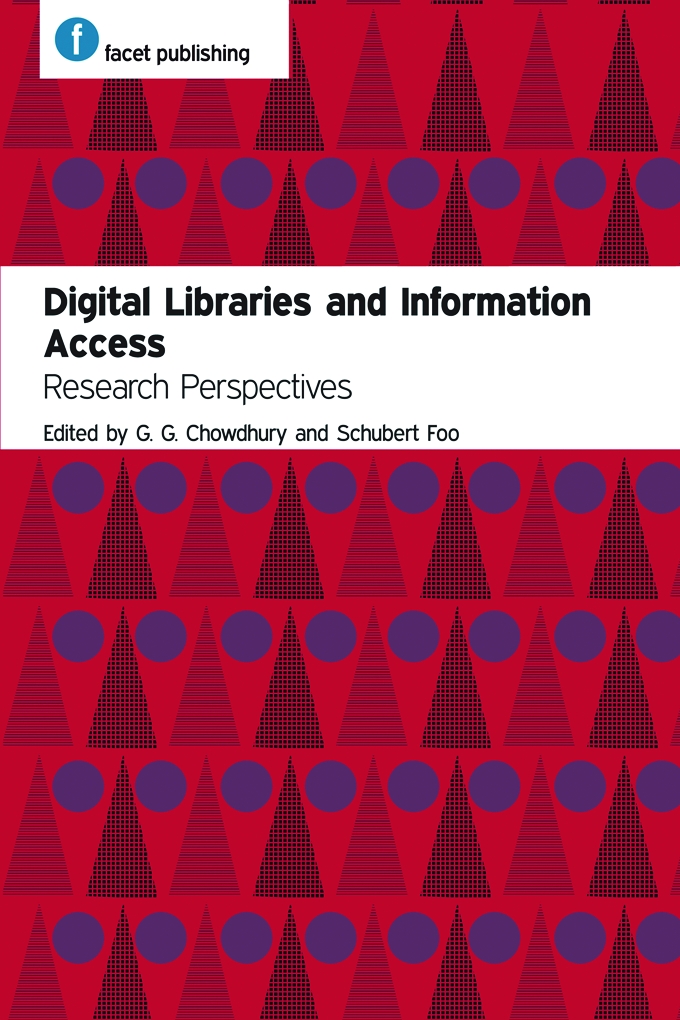Book contents
- Frontmatter
- Contents
- Foreword
- Editors and contributors
- 1 Digital libraries and information access: introduction
- 2 The design and architecture of digital libraries
- 3 Metadata and crowdsourced data for access and interaction in digital library user interfaces
- 4 Information access
- 5 Collaborative search and retrieval in digital libraries
- 6 The social element of digital libraries
- 7 Towards socially inclusive digital libraries
- 8 Users’ interactions with digital libraries
- 9 Digital libraries and scholarly information: technology, market, users and usage
- 10 Digital libraries and open access
- 11 iSTEM: integrating subject categories from multiple repositories
- 12 The usability of digital libraries
- 13 Intellectual property and digital libraries
- 14 Digital preservation: interoperability ad modum
- 15 Digital libraries and information access: research trends
- Index
- Miscellaneous Endmatter
8 - Users’ interactions with digital libraries
Published online by Cambridge University Press: 08 June 2018
- Frontmatter
- Contents
- Foreword
- Editors and contributors
- 1 Digital libraries and information access: introduction
- 2 The design and architecture of digital libraries
- 3 Metadata and crowdsourced data for access and interaction in digital library user interfaces
- 4 Information access
- 5 Collaborative search and retrieval in digital libraries
- 6 The social element of digital libraries
- 7 Towards socially inclusive digital libraries
- 8 Users’ interactions with digital libraries
- 9 Digital libraries and scholarly information: technology, market, users and usage
- 10 Digital libraries and open access
- 11 iSTEM: integrating subject categories from multiple repositories
- 12 The usability of digital libraries
- 13 Intellectual property and digital libraries
- 14 Digital preservation: interoperability ad modum
- 15 Digital libraries and information access: research trends
- Index
- Miscellaneous Endmatter
Summary
Introduction
Over the past ten years, the spread and diversity of digital libraries has increased enormously. Not only are ‘traditional’ libraries extending the scope of their activities by creating digital libraries of one kind or another, but learned societies, interest groups and other organizations are creating digital libraries of specialized scope to serve the information needs of their intended user groups and of the public at large.
The purpose of this chapter is to provide an overview of current trends in research on the interaction between users and digital libraries, to reveal the main results of that research and to explore the applicability of existing models of information behaviour to the digital library sphere. Generally, we have not sought to limit our definition of the digital library to a particular form, but have accepted what is described in the retrieved literature as a digital library. However, from the perspective of the information user, it seems reasonable to question why the term ‘library’ is used in this context.
Methods and scope of this study
If we perceive a library as nothing more than a room with books, then, by analogy, a file of electronic documents can be described as a ‘digital library’. The modern library, however, is much more than a room with books; it has associated services of various kinds, from reference services to interlibrary lending, and services directed to particular groups such as, in the public library sector, children's libraries and business libraries. Traditionally, special libraries in industry and beyond have offered translation and current-awareness services. Our proposition, therefore, is that the richer the array of services offered in the digital sphere, the more like a bricks-and-mortar library the digital library will be, and the richer the user experience of the library. The poorer the digital library is in these terms, the more like a repository or an archive it will be. One of the papers retrieved by the authors highlighted the difference between web archives and digital libraries, which provide more structured collections and enable the use of metadata, controlled vocabularies and authority files in the execution of searches.
Information
- Type
- Chapter
- Information
- Digital Libraries and Information AccessResearch perspectives, pp. 113 - 128Publisher: FacetPrint publication year: 2012
